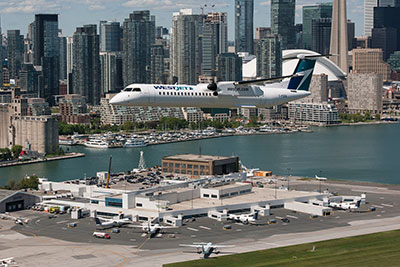
Features
Operations
Alternate Approach: The shrinking infrastructure
Business aviation in Canada is literally running out of landing strip. The Toronto Port Authority has proposed a 336-metre runway extension at Billy Bishop Airport, pictured, right, and a lifting of a jet ban to allow Porter Airlines to fly Bombardier CSeries twin jets from the downtown facility. If approved, it is not clear whether loosening the rules would make more room for business aviation.
July 9, 2013 By David Carr
Business aviation in Canada is literally running out of landing strip. The Toronto Port Authority has proposed a 336-metre runway extension at Billy Bishop Airport, pictured, right, and a lifting of a jet ban to allow Porter Airlines to fly Bombardier CSeries twin jets from the downtown facility. If approved, it is not clear whether loosening the rules would make more room for business aviation.

|
| It was widely reported at the time that $1.5 million was the difference between keeping the airport running and seeing it redeveloped. (Photo: WestJet)
|
But opening the convenient waterfront airport a crack will not start to balance out the loss of Buttonville, Canada’s busiest general aviation airport. It’s the closest Canadian BizAv has to a Van Nuys in California, America’s largest general aviation airport or Teterboro, the New Jersey general aviation “reliever” airport, a 20-kilometre cab ride to Manhattan.
Markham, Ont.-based Buttonville is the 11th busiest airport in Canada and a valuable asset for the general aviation community. But the land the airport sits on is even more valuable as a mixed-use commercial, residential and retail development as part of one of Canada’s fastest growing communities. Developer Cadillac Fairview bought the land from the owners of the privately held airport in 2009 for an undisclosed sum rumoured to be upwards of $150 million. The developer is expected to begin paving over the airfield by 2015, dispersing more than 136,000 annual aircraft movements to other airports within the country’s most crowded air transport corridor, and further removed from the Toronto core.
A similar script is being played out in Edmonton, where the local council began declaring “last orders” on the Alberta capital’s city centre airport in 2009. Since then, council has gradually phased out access, starving the airport of revenue to build the case that the facility is unsustainable.
It is estimated that Canada has 10 per cent of the number of paved airports that are available in the U.S. Considering populations, it is a solid line-by-line comparison. But domestically, Canadian business aviation covers more territory than does the U.S. with a thinner population spread over greater distances. Many of the paved runways Canada operates do not have runways long enough to support private jet transport.
This is a consequence of different airport building philosophies dating back more than 50 years. In the U.S., the government funded the construction of reliever airports near major population centres. The result is a general aviation infrastructure that enables private operators to sidestep congested commercial hubs and avoid the uneven tug of war between airlines and business aviation for access that occurs in Canada, especially over peak period slots. According to the Washington-based National Business Aviation Association, BizAv operations at America’s 20 busiest hub airports account for less than three per cent of total activity.
A yawning gap in airport philosophies still exists between Canada and the U.S., which does not bode well for advocates of increased airport capacity for business aviation. Toll booth versus spark plug is how the Canadian Senate characterized the difference in a report published last year. In the U.S., airports, including executive airports, are seen as economic engines, whereas in Canada airports have switched to a more aggressive user-pay model. It is precisely this move that may prevent capacity catching up with the need.
When lower traffic volumes caused the Greater Toronto Airports Authority (GTAA) to cancel a $1.5-million annual payment to Buttonville in return for supporting Pearson as a reliever airport, the federal government refused to open its cheque book, even though the GTAA paid more than $140 million in ground rent that year and Buttonville’s status as an economic generator was well established. It was widely at the time that $1.5 million was the difference between keeping the airport running the owners hammering in the “for sale” sign.
As Washington wrestles with its debt and some American municipalities, which own the airports and charge no tax, teeter on bankruptcy, it is likely that the U.S. will move closer to the Canadian model. Still, unlike Canada, the U.S. already has the infrastructure in place to support business aviation.
Relief may be in sight. The federal government recently dusted off plans for a second Toronto Airport, northeast of a city on a proposed airport site from the 1970s. The Canadian Business Aviation Association (CBAA) and stakeholders have also been successful in having local and regional airports included on the agenda for community infrastructure funding. It will be a tough slog. Making recreational centres, swimming pools and other community supports take a back seat to the perception of pampered executives and their expensive toys always will be an unpopular decision. Corporate Canada has traditionally been jittery about drawing attention to business jets. That is going to have to change. The industry is growing and the airplanes have to go somewhere.
David Carr is a Wings writer and columnist.